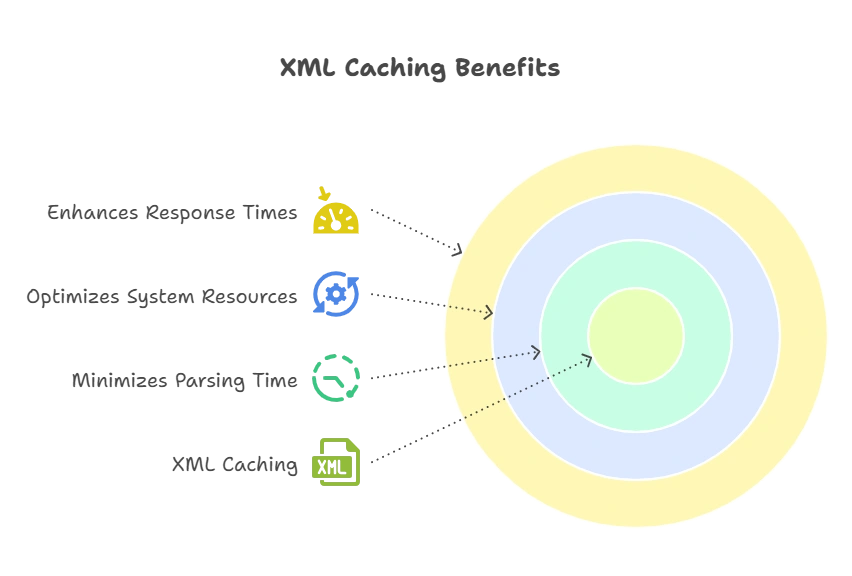Strategies for XML Caching
In XML-based applications, caching is essential to improving performance, reducing load times, and increasing efficiency. This chapter will cover the basics of XML caching, move through different caching strategies, and explain how each method can optimize XML data handling. Each section includes code examples to illustrate the concepts, providing a comprehensive understanding of how to implement effective XML caching.
Introduction to XML Caching
XML caching involves storing XML data temporarily, allowing it to be accessed quickly when needed. Instead of repeatedly parsing the same XML file, caching retrieves the data from a fast-access storage location. This minimizes parsing time, optimizes system resources, and enhances response times.

Types of XML Caching Strategies
There are several caching strategies for handling XML data effectively, depending on the data’s frequency of access, size, and the requirements of the application. Key strategies include:
- In-Memory Caching
- Disk-Based Caching
- Database-Driven Caching
- Distributed Caching
- Selective Caching (Partial Caching)
In-Memory Caching
In-memory caching is one of the most commonly used caching techniques. It stores XML data in RAM, making access extremely fast. This method is ideal for small to medium-sized XML data that requires frequent access.
Code Example for In-Memory Caching:
In this example, we store the XML data in a Python dictionary, which acts as an in-memory cache.
import xml.etree.ElementTree as ET
# Sample XML data
xml_data = '''<Library><Book><Title>Book A</Title></Book></Library>'''
# In-memory cache
cache = {}
# Load data into cache if not already cached
if "library_data" not in cache:
cache["library_data"] = ET.ElementTree(ET.fromstring(xml_data))
# Accessing cached data
cached_xml = cache["library_data"]
for book in cached_xml.findall('.//Book'):
print(book.find('Title').text) # Output: Book A
Explanation:
- The XML data is stored in the
cachedictionary. - This eliminates repeated parsing, making retrieval instantaneous.
Disk-Based Caching
Disk-based caching stores XML data on disk instead of memory, allowing larger data to be cached persistently across sessions. This method is particularly useful for data that is too large for in-memory storage but is accessed often enough to warrant caching.
Code Example for Disk-Based Caching:
In this example, we save the XML data to a local file and retrieve it as needed.
import os
import xml.etree.ElementTree as ET
xml_data = '''<Library><Book><Title>Book A</Title></Book></Library>'''
# Write XML data to disk
with open("library_cache.xml", "w") as file:
file.write(xml_data)
# Read XML data from disk cache
if os.path.exists("library_cache.xml"):
tree = ET.parse("library_cache.xml")
root = tree.getroot()
for book in root.findall('.//Book'):
print(book.find('Title').text) # Output: Book A
- Explanation:
- XML data is saved in a file named
library_cache.xml. - The file can be read as often as needed without re-parsing or reloading from the source.
- XML data is saved in a file named
Database-Driven Caching
This strategy stores XML data in a database, allowing you to use database operations to manage cache. Database caching provides persistence, scalability, and support for more extensive data sets.
Code Example for Database Caching (Using SQLite):
import sqlite3
import xml.etree.ElementTree as ET
# Sample XML data
xml_data = '''<Library><Book><Title>Book A</Title></Book></Library>'''
# Database connection
conn = sqlite3.connect("xml_cache.db")
cursor = conn.cursor()
# Create cache table
cursor.execute("CREATE TABLE IF NOT EXISTS xml_cache (id INTEGER PRIMARY KEY, data TEXT)")
# Insert XML data
cursor.execute("INSERT INTO xml_cache (data) VALUES (?)", (xml_data,))
conn.commit()
# Retrieve XML data from cache
cursor.execute("SELECT data FROM xml_cache WHERE id = 1")
cached_xml = cursor.fetchone()[0]
root = ET.fromstring(cached_xml)
# Process XML data
for book in root.findall('.//Book'):
print(book.find('Title').text) # Output: Book A
# Close database connection
conn.close()
Distributed Caching
For applications with high availability requirements, distributed caching spreads cached XML data across multiple nodes in a network. This enhances scalability, reliability, and access speed, especially for applications accessed by many users.
Common tools for distributed caching:
- Redis: Stores key-value pairs and supports data replication and expiration.
- Memcached: An in-memory caching tool designed for fast access.
Code Example Using Redis for Distributed XML Caching:
import redis
import xml.etree.ElementTree as ET
# Connect to Redis server
r = redis.Redis()
# Sample XML data
xml_data = '''<Library><Book><Title>Book A</Title></Book></Library>'''
# Store XML in Redis
r.set("library_data", xml_data)
# Retrieve XML data from Redis cache
cached_data = r.get("library_data")
root = ET.fromstring(cached_data)
# Display cached XML data
for book in root.findall('.//Book'):
print(book.find('Title').text) # Output: Book A
Selective Caching (Partial Caching)
Selective caching involves caching only certain parts of an XML document. It’s ideal for large XML files when only specific elements or sections need frequent access. This approach reduces memory usage and speeds up retrieval.
Code Example for Selective Caching:
# Sample XML data
xml_data = '''<Library><Book id="1"><Title>Book A</Title></Book><Book id="2"><Title>Book B</Title></Book></Library>'''
# Selective cache for Titles only
title_cache = {}
root = ET.fromstring(xml_data)
for book in root.findall('.//Book'):
book_id = book.get('id')
title_cache[book_id] = book.find('Title').text
# Access cached titles
print(title_cache["1"]) # Output: Book A
print(title_cache["2"]) # Output: Book B
Expiration and Invalidation Policies
Managing cached data includes setting expiration times, ensuring data is current. Expiration defines how long data remains valid, while invalidation removes outdated or invalid data.
Code Example for Expiration (Using Redis):
# Setting an expiration time on cached data in Redis
r.set("library_data", xml_data, ex=60) # Cache expires in 60 seconds
Choosing the Right Caching Strategy
Selecting the best strategy involves understanding application needs:
- Small, frequent data access: In-memory caching is ideal.
- Persistent, large data: Disk or database caching works best.
- High-availability applications: Distributed caching ensures accessibility.
- Selective access: Use partial caching for large datasets with specific access points.
XML caching is a versatile tool for enhancing the performance of XML-based applications. Each caching strategy offers specific benefits, allowing developers to balance speed, persistence, and memory efficiency. By implementing the appropriate caching method, applications can handle XML data more efficiently, providing faster and more reliable responses for users. Happy coding !❤️
